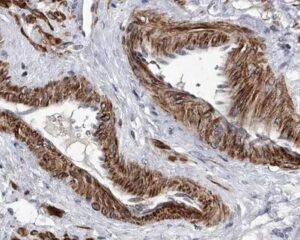The Testican family, also designated the BM-40/SPARC/osteonectin family, is composed of highly conserved, extracellular, calcium-binding, sulfate proteoglycans. Expression of Testicans is detected in a variety of tissues, but is most abundant in brain. Family members include Testican-1 (also known SPOCK1), Testican-2 (SPOCK2), Testican-3 (SPOCK3) and an amino-terminal splice variant of Testican-3, designated N-Tes. SPOCK1 is specifically expressed in the thalamus of the brain, and is upregulated in activated astroglial cells of the cerebrum where it mediates neuronal attachment and matrix metalloproteinase activation. After a neural injury, such as a cerebral stroke, SPOCK1 expression is upregulated in astrocyte cells in order to inhibit the ability of the protein Neuro-2a to form neurite extensions. SPOCK1 is also a component of joint and of the growth plate cartilage that may participate in the regulation of matrix turnover.
Clone
Polyclonal
Isotype
IgG
Host species
Rabbit
Species Reactivity
Human
Cellular Localization
Secreted, extracellular space
Positive Control
Prostate
Applications
IHC, ICC/IF, WB
Intended Use
Research Use Only

